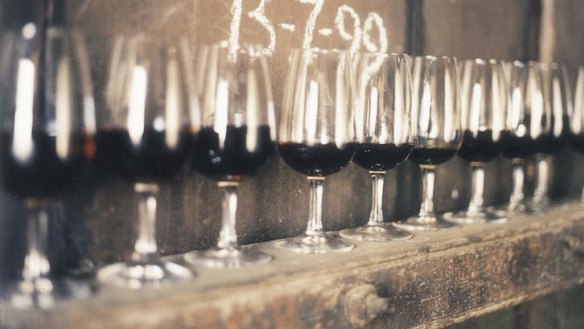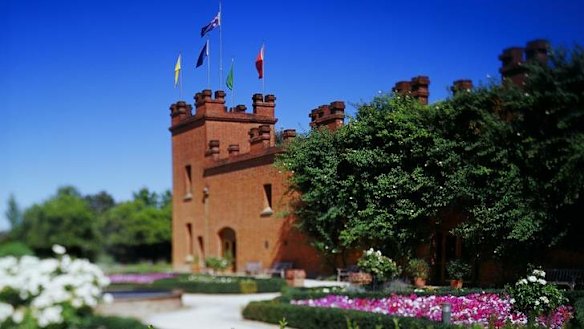Four ways to classify muscat

Not only do Rutherglen's winemakers produce the world's most luscious and complex fortified muscat and topaque (muscadelle), they have a unique system of classifying them. There are four levels of quality that loosely correlate with age, but most importantly, style. The older the blended age of these non-vintage wines, the more rich, complex and profound they are in bouquet and flavour.
Other countries make fortified muscat but not with the richness found in north-eastern Victoria, thanks to its unique combination of climate, soil and grape variety. There are few digestif wines more satisfying at the end of a meal than a small glass of this dark-amber, viscous, heady, meditational essence. Serve it with a great blue cheese, some freshly shelled nuts, dried fruits and dark chocolates and you're in heaven.
The four levels of quality form a pyramid, with the tiniest volumes of the greatest old wines at the apex. At the bottom is basic Rutherglen muscat (or topaque), which is sold in the largest volumes and is most affordable, at around $20 a bottle. Then we move up through Classic (around $30 to $40) to Rare and finally, Grand. These also correspond to price, although every winery sets its own price levels. Grand is priced around $65 a half-bottle and Rare is well over $100 a half. Museum wines are occasionally produced and can sell for many hundreds of dollars (All Saints' Museum Rare Muscat is $1000 for 500ml).

Much is made of the fact that there are no prescribed age parameters, the point being that it is more about style than age. The winemakers point out that a muscat or topaque matured in a large barrel will develop more slowly than the same wine in a small barrel, and the effect on flavour and character will be different. The same can be said for the temperature of the cellar: some cellars are hotter than others; indeed, some wineries store their fortified wines just under a galvanised iron roof to maximise the heat. The hotter the ambient temperature, the faster the wine will age.
However, the unwritten aspect of winemakers playing down the significance of age is surely that some wineries have much greater access to old stocks than others. All Saints, Campbells, Chambers and Morris all have very old stocks, and even a small quantity of very old wine can boost the depth and character when added to a blend. Morris, for example, was established in 1859 and has carefully protected its depth of very old fortified wines kept in barrel.
All Saints was established in 1864 and is celebrating its 150th anniversary this year. When it changed hands about 25 years ago, a lot of old stock was sold off, but the wines continue to exhibit great aged character.
Two other wineries, Pfeiffer and Stanton & Killeen, don't have the same depth to their aged stocks.
Pfeiffer, for example, was established only 30 years ago, yet its Grand and Rare muscat and topaque are close to as great as the ''old masters'' of the district.
Simply put, the various styles are as follows:
Rutherglen: Fresh, youthful fruit and clean spirit, with palate length and richness.
Classic: A greater level of richness and complexity, with great length and a touch of rancio (a particular character derived from long-term wood-ageing).
Grand: A higher plane of character, with great concentration and lusciousness, and lots of rancio among many layers of matured complexity.
Rare: Very special and very old, blended from the richest and most complete wines in the cellar, bottled in tiny quantities.
On top of the obvious ingredients of the great wines - age and blending skill - the grapes themselves at harvest are of increasing concentration, quality and sweetness as we ascend the pyramid.
Grand and Rare muscats and topaques are expensive, but they are actually cheap when the cost of producing them is tallied. And unlike table wines, a bottle can be enjoyed over several days or even weeks.
And in case you were wondering, topaque is Rutherglen's name for its sweet, fortified, wood-aged wines made from the muscadelle grape. They were formerly known as liqueur tokay, until the European authorities decided Hungary's tokaji producers should have the name to themselves.
Taste-testing the glass
A wine needs the right glass just as a painting needs the right frame, quoth veteran English wine author Hugh Johnson. But exactly what kind of glass shape would best frame Rutherglen muscat? That was the question on everyone's lips when Austrian crystal wine glass guru Georg Riedel visited Rutherglen recently.
Riedel and five local wineries staged a complicated tasting at which winemakers and wine writers sampled muscats of each quality level and producer, from 14 different Riedel glass shapes.
We were asked to find the most suitable, by a process of elimination.
The shapes ranged from the stemless Riedel 'O' Spirits glass, to the utilitarian $20 Ouverture red and white glasses through to the $100-plus, hand-made Cognac and Sauternes glasses from the Sommelier range. There was quite good agreement among the tasters and when it came down to three preferred shapes, most of us had favoured one or two from the beginning.
There seemed to be a consensus that the larger-bowl shapes amplified the spirit too much, while the very small ones were too constricting. We didn't want a glass that emphasised any single feature of the wines, but rather, we sought the glass that presented the wine most truly.
This in my opinion, and happily nearly everyone else's, was the $20 Ouverture white wine glass.
The second choice, and Georg Riedel's favourite, was the Sommelier XO Cognac glass, a thistle shape that polarised the winemakers among us, some feeling it made the aroma too spirity.
